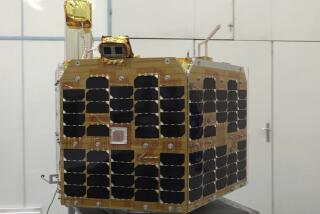Soviets Launch Space Lab Due to Be ‘Factory’ Hub
MOSCOW — The Soviet Union sent into orbit Thursday a space station that is expected to become the hub of a permanently manned “space factory.”
There were no cosmonauts on board the craft, which is named “Mir,” or “Peace,” and is dedicated to the 27th Congress of the Communist Party of the Soviet Union, scheduled to open next Tuesday.
Crews are to go up later, after tests are carried out with unmanned craft to see if the space station is working properly, the news agency Tass said. It did not say how long the tests might last.
Tass said Mir is equipped with docking stations to accommodate six visiting spacecraft at once. It said it will be “a base module for assembling a multipurpose, permanently operating manned complex.”
Soviet officials described the vehicle as a “third-generation space laboratory,” larger and more comfortable than Salyut 7, which has been in orbit since 1982.
Small Private Cabins
Tass said that cosmonauts on Mir will have small private cabins that contain a desk, a built-in stove, an arm chair and a sleeping bag.
It said Mir will be able to link up with other space modules--big spacecraft with their own controls and life-support systems--to be used as workrooms. One module may be a shop for technological production and experiments, Tass said, and others may be designated for biological research, production of medicines or astrophysical work.
Alexei Leonov, deputy head of the cosmonauts’ training center, said, “Practical cosmonautics has now entered a new stage--the beginning of a transition from research and experiments to large-scale production activities in outer space.”
Mir was launched from the Baikonur space center in the Central Asian desert in the early hours of the morning. There was no advance word. The launch came less than a month after the U.S. space shuttle Challenger exploded just after lift-off, killing the seven astronauts on board and delaying other scheduled missions.
Not as Sophisticated
The United States is designing a space station that is expected to go into orbit in the 1990s. Western analysts in Moscow said that Mir is not as sophisticated as the proposed American spacecraft.
Dimensions and other details of Mir were not made public, but photographs indicate that it is larger than Salyut 7. Nor was there any indication of how many cosmonauts might be assigned to the station, although Tass said that crews are already training for flights to Mir.
Leonov, explaining how the new craft was named, said, “We want to emphasize once again that the Soviet program . . . is intended solely for peaceful purposes.”
Many military officers have been associated with the Soviet space program, however, and Baikonur, where the launching took place, is a secret installation rarely visited by foreigners.
The last Soviet space mission, in November, was cut short when the commander, Vladimir Vasyutin, became ill and the spacecraft returned to Earth. Earlier, three cosmonauts set an endurance record of 238 days on board Salyut 7.
More to Read
Sign up for Essential California
The most important California stories and recommendations in your inbox every morning.
You may occasionally receive promotional content from the Los Angeles Times.










